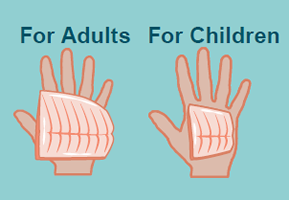Mokelumne River, Lower
Advisory for non-migratory fish based on mercury. Advisory for fish that migrate based on mercury or PCBs.
The Lower Mokelumne River posters were revised in November 2022 to include the updated advice for American Shad, Chinook (King) Salmon, Steelhead Trout, Striped Bass, and White Sturgeon, based on the Advisory for Fish that Migrate.
NOTE: Asian Clam and crayfish advice was removed while OEHHA evaluates other contaminants in these species that may affect advice.
Biotoxins from harmful algal blooms (HABs) may be found in California water bodies, see Resources related to Biotoxins and Harmful Algal Blooms for more information.
Waterbody
Women 18-49 Years and Children 1-17 Years
Women 50 Years and Older and Men 18 Years and Older
What is a serving?

The recommended serving of fish is about the size and thickness of your hand. Give children smaller servings. For small fish species, several individual fish may make up a single serving.
Preparing and Cooking Fish
- For fish, eat only the skinless fillet.
- For shellfish, eat only the meat.
- Some chemicals are higher in the skin, fat, and guts.
- Remove and throw away the skin before cooking.
- Cook thoroughly and allow the juices to drain away.
![]() = Fish that are high in omega-3s and you can eat them at least once a week.
= Fish that are high in omega-3s and you can eat them at least once a week.
Eating fish with omega-3s can lower heart disease in adults and help babies’ brains to develop.
Resources related to Biotoxins and Harmful Algal Blooms
Harmful algal blooms are increasing in California and may occur throughout the year in some water bodies. OEHHA recommends that you check the California harmful algal bloom (HAB) portal to see if a bloom has been reported at this water body and learn healthy water habits to protect yourself, your family, and your pets during your visit.
Fish, Incident Response, Seafood Safety, and Harmful Algal Bloom Section
Sacramento Office
1001 I Street
Sacramento, CA 95814
Phone: (916) 324-7572
Fish@oehha.ca.gov









